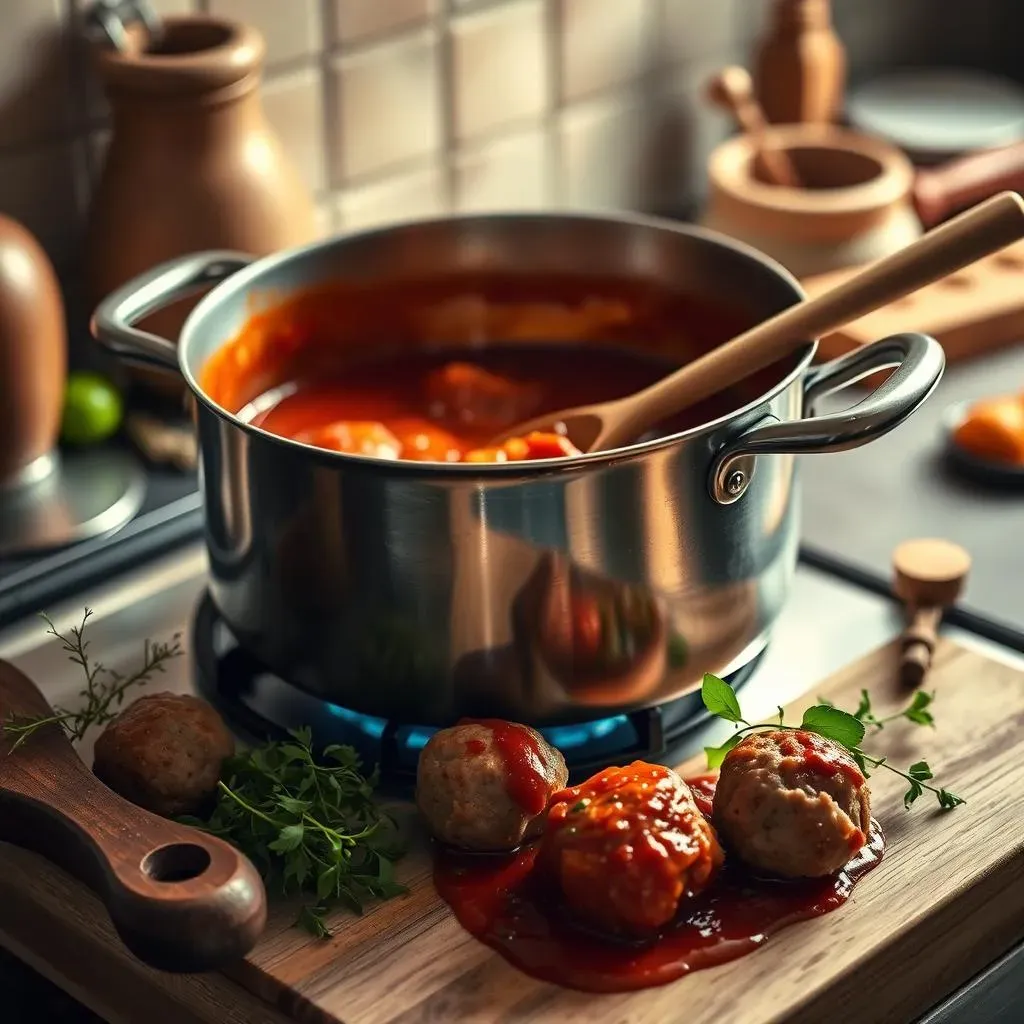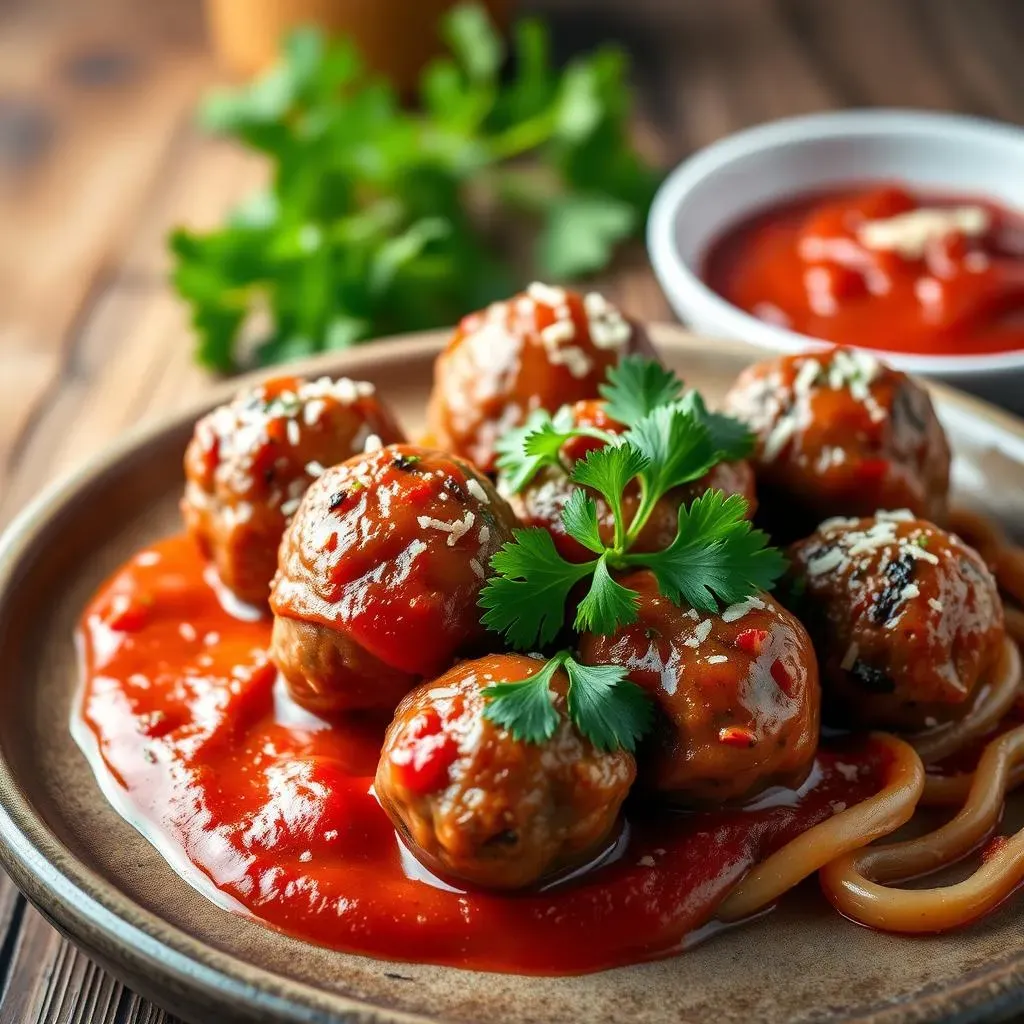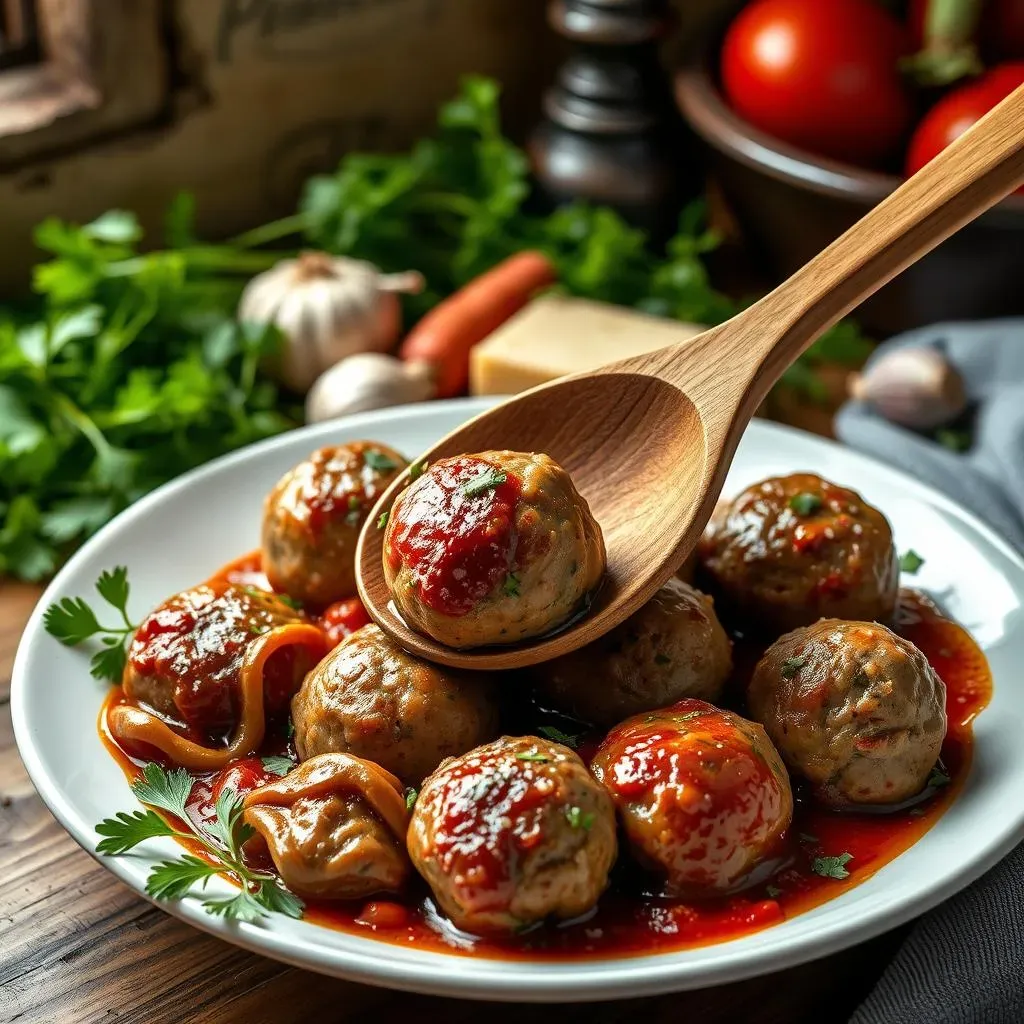Table of Contents
There's something magical about the aroma of simmering tomato sauce and the anticipation of biting into a perfectly cooked meatball. For me, it always brings back memories of Sunday dinners at my grandmother's house, where her secret recipes for Italian meatballs were the star of the show.
Perfecting Your Italian Meatballs Recipe: A StepbyStep Guide

Perfecting Your Italian Meatballs Recipe: A StepbyStep Guide
Alright, let's get down to brass tacks about perfecting your Italian meatballs recipe. Forget those tough, flavorless hockey pucks you might have encountered. We're aiming for melt-in-your-mouth tenderness and a flavor explosion that'll have everyone begging for seconds. It all starts with the right ingredients and a little bit of know-how.
First things first, the meat. A blend is your best bet. I usually go for a mix of ground beef and ground pork – the beef gives you that classic meatball flavor, while the pork adds richness and moisture. Some people swear by adding ground veal, but I find the beef and pork combo works just fine. The ratio? I'd say about 50/50, or maybe lean slightly towards more beef if you prefer a less fatty meatball. Experiment and see what you like best!
Next up, the binder. This is crucial for keeping your meatballs tender and preventing them from drying out. The classic choice is breadcrumbs soaked in milk. The breadcrumbs absorb the milk and create a panade, which acts as a moisture reservoir during cooking. Don't skimp on this step! Use fresh breadcrumbs if you can – they'll give you a lighter, more delicate texture. If you're using dried breadcrumbs, make sure to soak them in milk for at least 10 minutes before adding them to the meat mixture.
Now, for the flavor boosters! This is where you can really get creative. Garlic is a must, of course. I like to use a generous amount – about 2-3 cloves, minced finely. Fresh parsley is another essential ingredient. Chop it up nice and small and add a handful to the meat mixture. And don't forget the cheese! Grated Parmesan and ricotta are both excellent choices. The Parmesan adds a salty, savory note, while the ricotta adds moisture and creaminess.
Ingredient | Purpose | Tips |
|---|---|---|
Ground Beef & Pork | Flavor & Moisture | 50/50 ratio is a good starting point. |
Breadcrumbs & Milk | Binder & Moisture | Soak breadcrumbs in milk for at least 10 minutes. |
Garlic & Parsley | Flavor | Use fresh, minced garlic and chopped parsley. |
Parmesan & Ricotta Cheese | Flavor & Moisture | Grate Parmesan finely; drain excess moisture from ricotta. |
Egg | Binding | Use one large egg per pound of meat. |
Finally, an egg to bind everything together. But here's a pro tip: don't overmix the meat mixture! Overmixing will develop the gluten in the breadcrumbs and make your meatballs tough. Mix everything together gently with your hands until just combined.
How Long to Cook Italian Meatballs: Achieving Tender Perfection

How Long to Cook Italian Meatballs: Achieving Tender Perfection
The Searing Secret
so you've got these beautiful meatballs, all mixed and ready to go. Now comes the big question: how long do you cook 'em? Well, it's not an exact science, but I'll give you the lowdown.
First, a little secret: searing. Before you even think about simmering them in sauce, give those meatballs a good sear in a hot pan with some olive oil. This does two things: it creates a beautiful crust that locks in the juices, and it adds a ton of flavor. Don't overcrowd the pan, sear them in batches, and get them nice and brown on all sides.
Simmering to Success
Once your meatballs are nicely seared, it's time to simmer them in sauce. This is where the magic happens. The sauce not only infuses the meatballs with flavor, but it also helps to keep them moist and tender.
How long you simmer them depends on the size of your meatballs. For smaller meatballs (about 1 inch in diameter), 15-20 minutes should do the trick. For larger meatballs (like the ones my grandma used to make!), you might need to simmer them for 30-45 minutes. The key is to make sure they're cooked through but not overcooked. You want them to be firm but still juicy.
Checking for Doneness
So, how do you know when your meatballs are done? The best way is to use a meat thermometer. Insert the thermometer into the center of a meatball. It should register 160°F (71°C). If you don't have a meat thermometer, you can cut one open to check. The center should be cooked through and no longer pink.
Remember, overcooked meatballs are dry and tough, so err on the side of caution. It's better to undercook them slightly than to overcook them. They'll continue to cook in the sauce even after you take them off the heat.
Tips for Perfect Meatballs
- Sear the meatballs before simmering for added flavor.
- Simmer in sauce for at least 15-20 minutes, or longer for larger meatballs.
- Use a meat thermometer to check for doneness (160°F/71°C).
- Don't overcook!
Storing and Freezing Italian Meatballs: Tips and Tricks

Storing and Freezing Italian Meatballs: Tips and Tricks
Short-Term Storage: Keeping Meatballs Fresh
so you've made a batch of amazing Italian meatballs, but you've got leftovers. No problem! Storing them properly will keep them fresh and delicious for days. If you plan on eating them within 3-5 days, the fridge is your best bet.
The key is to store them in an airtight container. Whether they're swimming in sauce or plain, make sure they're properly sealed to prevent them from drying out or absorbing any weird fridge odors. I usually store mine in a glass container with a tight-fitting lid. If you've got a lot of sauce, you can store the meatballs and sauce together, which actually helps keep them moist and flavorful.
Long-Term Storage: Freezing for Future Feasts
Now, if you're thinking longer-term, freezing is the way to go. Meatballs freeze beautifully, whether they're cooked or uncooked. Freezing uncooked meatballs is great if you want to have them on hand for a quick weeknight meal. Just form the meatballs as usual, place them on a baking sheet lined with parchment paper, and freeze them until solid. Once they're frozen, transfer them to a freezer bag or container. This prevents them from sticking together in one big meatball blob.
For cooked meatballs, let them cool completely before freezing. Again, spread them out on a baking sheet to freeze individually before transferring them to a freezer bag. If you're freezing them in sauce, make sure the sauce is also cooled down first. Portion them out into freezer-safe containers, leaving a little bit of headspace for expansion. Properly frozen meatballs can last for up to 3 months without losing too much quality.
Storage Method | Cooked/Uncooked | Container | Shelf Life |
|---|---|---|---|
Refrigerator | Cooked | Airtight container | 3-5 days |
Freezer | Uncooked | Freezer bag (pre-frozen individually) | Up to 3 months |
Freezer | Cooked | Freezer bag or container (pre-frozen individually) | Up to 3 months |
The Best Recipes for Italian Meatballs: Ingredients and Detailed Method

The Best Recipes for Italian Meatballs: Ingredients and Detailed Method
let's get to the heart of the matter: the best recipes for Italian meatballs. I'm going to share a recipe that's been passed down in my family for generations, with a few tweaks of my own. This isn't just a recipe; it's a labor of love, and it's guaranteed to produce the most tender, flavorful meatballs you've ever tasted. First, let's talk about the ingredients. You'll need:
- 1 pound ground beef (80/20 blend)
- 1/2 pound ground pork
- 1 cup fresh breadcrumbs
- 1/2 cup milk
- 1/4 cup grated Parmesan cheese
- 1/4 cup grated Pecorino Romano cheese
- 2 large eggs, lightly beaten
- 2 cloves garlic, minced
- 1/4 cup chopped fresh parsley
- 1 teaspoon dried oregano
- 1/2 teaspoon salt
- 1/4 teaspoon black pepper
- 1 (28 ounce) can crushed tomatoes
- 1 (15 ounce) can tomato sauce
- 1/4 cup olive oil
Now, for the method. Start by soaking the breadcrumbs in milk for about 10 minutes. This will create a panade, which will help keep the meatballs moist and tender. In a large bowl, combine the ground beef, ground pork, soaked breadcrumbs, Parmesan cheese, Pecorino Romano cheese, eggs, garlic, parsley, oregano, salt, and pepper. Mix everything together gently with your hands until just combined. Don't overmix!
Next, form the meat mixture into meatballs. I like to make mine about 2 inches in diameter, but you can make them smaller or larger if you prefer. Heat the olive oil in a large skillet over medium-high heat. Add the meatballs to the skillet and brown them on all sides. You may need to do this in batches to avoid overcrowding the pan. Once the meatballs are browned, add the crushed tomatoes and tomato sauce to the skillet. Bring the sauce to a simmer, then reduce the heat to low, cover, and simmer for at least 1 hour, or up to 2 hours. The longer you simmer them, the more flavorful they'll be.
Step | Description | Tips |
|---|---|---|
Soak Breadcrumbs | Soak breadcrumbs in milk | Let soak for 10 minutes |
Combine Ingredients | Mix all ingredients gently | Don't overmix! |
Form Meatballs | Shape mixture into meatballs | About 2 inches in diameter |
Brown Meatballs | Sear meatballs in olive oil | Brown on all sides |
Simmer in Sauce | Cook in tomato sauce | Simmer for 1-2 hours |
Serve the meatballs over your favorite pasta, with a generous spoonful of sauce and a sprinkle of Parmesan cheese. Mangia!
Nutritional Information for Italian Meatballs

Nutritional Information for Italian Meatballs
Understanding the Basics
so you're whipping up a batch of these delicious Italian meatballs. Great! But have you ever stopped to think about what's actually *in* them? Knowing the nutritional information for Italian meatballs can help you make informed choices about your diet and enjoy your meatballs guilt-free (well, mostly!). We're talking calories, protein, carbs, fats – the whole shebang. And remember, these values can vary quite a bit depending on the specific recipe and ingredients you use.
Generally, Italian meatballs are a good source of protein, thanks to the meat. They also provide some carbohydrates from the breadcrumbs and sauce, and fats from the meat and cheese. But let's break it down further.
Key Nutrients Breakdown
Let's talk specifics. A typical serving of Italian meatballs (about 3-4 meatballs) might contain:
- Calories: 300-400
- Protein: 20-25 grams
- Carbohydrates: 20-30 grams
- Fat: 15-25 grams
But here's the deal: these are just estimates. The type of meat you use (lean beef vs. regular ground beef), the amount of cheese, and whether you use a homemade or store-bought sauce can all significantly impact these numbers. For example, using lean ground beef will lower the fat content, while adding more cheese will increase it.
Also, keep in mind that the sauce you serve them with plays a big role. A simple tomato sauce will be lower in calories and fat than a creamy Alfredo sauce.
Making Healthier Choices
Want to enjoy your Italian meatballs without completely derailing your healthy eating goals? Here are a few simple swaps you can make:
Ingredient | Swap | Benefit |
|---|---|---|
Regular Ground Beef | Lean Ground Beef or Ground Turkey | Lower Fat Content |
White Breadcrumbs | Whole Wheat Breadcrumbs | More Fiber |
Full-Fat Cheese | Part-Skim or Reduced-Fat Cheese | Lower Fat Content |
Store-Bought Sauce | Homemade Tomato Sauce (with no added sugar) | Control over Ingredients, Lower Sugar |
By making these small changes, you can significantly reduce the calorie and fat content of your Italian meatballs without sacrificing too much flavor. It's all about balance!
Also, consider your portion size. It's easy to overeat when something is as delicious as Italian meatballs, so be mindful of how much you're serving yourself. Pair them with a big salad or some steamed vegetables to round out your meal and add some extra nutrients.
Conclusion: Mastering the Art of Italian Meatballs
So there you have it – your comprehensive guide to creating unforgettable Italian meatballs. From understanding the nuances of ingredient selection to mastering the cooking process, you’re now equipped to whip up a batch that will impress even the most discerning palates. Whether you stick to the classic recipe or experiment with your own creative twists, remember that the key to truly exceptional meatballs lies in the quality of your ingredients, the care you put into the preparation, and the love you share when serving them. Now go forth and create some meatball magic!